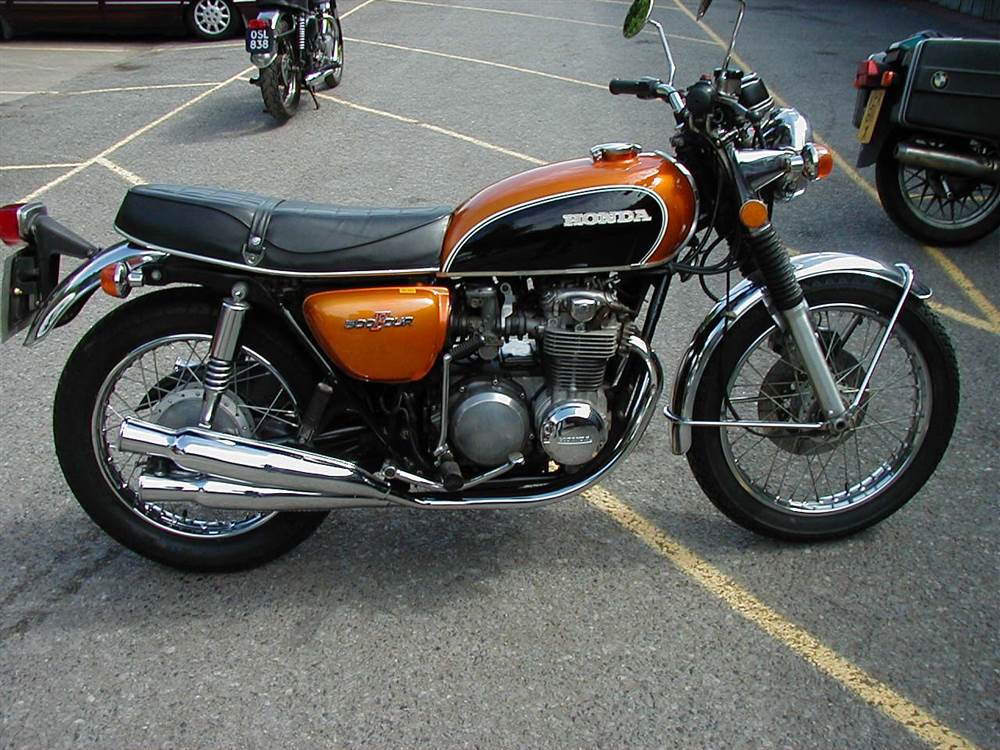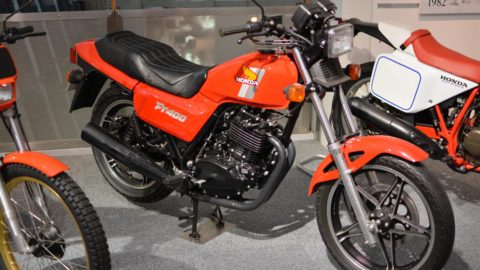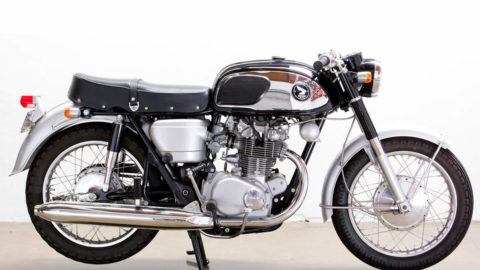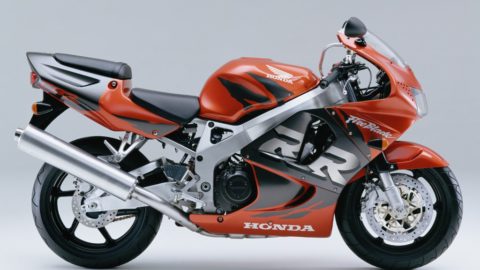The Sixties
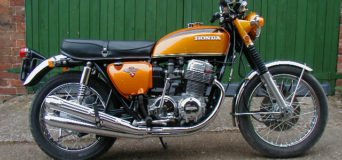
Honda CB750 K1
The bike that defined the sixties was undoubtedly Honda’s CB750, though there was a lot that was bad about it, its overwhelming impression was good. It put to rest, once and for all, the idea that the Japanese couldn’t build big bikes. Its OHC four cylinder engine contained technology that most British factories could not even build in their one-off race machinery and it was the sheer effrontery of the Japanese company to so redefine production engineering that sets the CB apart. Triumph had their triple but they didn’t have the reliability, oil tightness and electric starter of the CB750.
The Honda was heavy, sported poor suspension, still had chain primary drive (albeit hyvoid) and a separate oil tank but none of that really mattered. What counted was the ease with which it could be ridden, how little effort was needed to keep it from falling apart. Not the fastest machine in the Kingdom it nevertheless was one of the few bikes that could be poked along at ton-plus speeds without living in fear of engine self-destruction. All meaningless by today’s standards but revolutionary back then.
In engineering terms, Honda’s earlier attempt at a big bike was more meaningful. The CB450, known as the Black Bomber, took all of Honda’s hard won vertical twin knowledge and distilled some unique engineering. Most interesting, the DOHC top end which sports torsion bars instead of valve springs and rockers set on eccentric shafts for ease of valve clearance setting. The crank throw was 180 degrees rather than the usual 360 degrees in British twins, giving perfect primary balance but a torque reaction along the crankshaft.
43 horses, 410lbs, a proper tubular frame and rather soft suspension added up to a mixture of good and bad times on the road; a marvellous mix of grouchy low rev torque and high rev power punch that would let the bike cruise along at 90mph plus without the usual grinding vibration. Every later Jap vertical twin can trace its roots back to the venerable Black Bomber. The excellence of its engineering apparent in the tiny valve clearances and the fact that it would turn in 70mpg whilst holding 90mph. A good ‘un!
Ugly were the legion of Honda twins before they heard about style, almost anything before 1960 but to be fair by that decade they only had the odd aberration in their step-thru’s and mini-bikes. Even the commuter CD175 of the late sixties couldn’t really be called blotto, time certainly kind to its pressed steel frame and dumpy mudguards.
Back to the good, the sixties Dream series certainly fits the bill, both CB72 250cc and CB77 305cc vertical twins. Sharing a lot of the engineering with the later CB450, they had simpler OHC heads and spine frames that used the engine as a stressed member. High revving by British bike standards they could give the 500 twins of the day a good run for their money, held together despite the unheard of revs their motors could be buzzed to.
Like most Hondas of this era the Dream excelled in its motor but was less than perfect in its chassis but nothing a bit of work on the suspension couldn’t cure and there is enough performance in the CB77 to make it on modern roads! The same can be said of Triumph 500 twins, and the like, of the era but only after they have been totally re-engineered!
Better yet than the CB72/77, the CB250K1 – a sort of mini Black Bomber with SOHC top end – offered the first 100mph 250cc twin (as in learner legal back then) in 1968. Okay, it needed a long road with either assistance from a hill or wind to achieve that, but the fact that the motor could rev to eleven grand without bursting its seam was history in the making! This was a decade of progress, the K1 had more power and better handling than the CB72, something not so universally achieved in the next decade! Hardly surprising that the K1 was immensely popular with new riders, nor that shocking that most were revved and ridden into the ground.
Yamaha spent the same decade producing many godawful ugly strokers, not getting into the game until as late as 1967. Ugly were such two strokes as the YD3, YES2 and YDS-3, though they sported all the conventional chassis bits that you might expect and benefited from the famed TD1’s progress on the race track. Only towards the end of the decade did Yamaha get their act together, most notably with the smaller 125cc stroker twin, the YAS1, though lacking in excess power at 15hp it would sing its heart out in a way that rival Bantams never, ever, managed.
Yamaha were also perfecting their 250/350 stroker twins at that time, the YDS’s slowly mutating into a semblance of Western style, though the first RD’s took the classic shape as far it could go in the stroker world, but that didn’t happen until the beginning of the next decade.
The ugliest bike Yamaha ever produced? Probably the 1965 YAS1, an inspiration for the later YB100, though many of the early sixties twins appeared to get their styling cues from behind the Iron Curtain! Apart from relatively advanced stroker engineering, Yamaha’s other great innovation of the decade was perfecting the form of the off-roader, the basics for the later DT175 already formed by 1968 in both 250 and 125cc trailsters – bikes that were able to run rings around the heavyweight Brit four strokes as well as being unexpectedly tough.
Suzuki were the other major proponent of the stroker cause in the sixties, they swapped the racier edge of the Yamahas for greater versatility; an act that also allowed them to develop bigger twins. Easily the best stroker of the decade, the T500 had performance that scared British 650’s, an amazing amount of engine toughness and handling that merely needed a bit of help from upgraded suspension. It was also in another, better, world as regards to smoothness and lack of vibration.
The big 500 had its origins in the earlier, smaller stroker twins – even in 1965 the T20, for instance, had a passing stab at classic styling, couldn’t be written off as ugly. 25 horses at 8000 revs made it a bit of a flyer for the day, especially as it only had to push along 320lbs. The 125 and 250cc versions were similarly virtuous but it’s mostly the tough old T500 that has managed to survive into the modern era.
The ugly, if not bad, title’s shared by the B120 and T125 Stinger. The latter a high revving twin with a penchant for self destruction that managed to merge road and trial styling in a thoroughly mad way – well, it was 1969, the end of a crazy decade. The Bloop (the original model was the B100P and the name stuck when the capacity was increased) was a sort of single cylinder stroker version of the CD but with even more hilarious commuter looks. The engine, though, was so tough that some of them manage to survive to this day. Oh, in the last year of the decade Suzuki also made an attempt at a stroker version of the famed Honda C50 step-thru; the F50 requiring a pretty big sick bucket.
Kawasaki’s sixties strokers didn’t make much of an impression until they acquired the rights to Bridgestone’s excellent 350 disc valve twin – possibility the second best stroker of the decade, right behind the T500 but so rare it’s hardly worth bothering trying to track one down. Both of Kawasaki’s late sixties stroker twins, 250 and 350cc, were flyers of ill-repute that presaged later triple madness.
For 1967, making 31 and 41 ponies, both 250 and 350, were well on the pace, able to burn off just about everything of similar capacity that could still turn a wheel. The 350 a devourer of both 500 and 650cc vertical twins. These weren’t heavy bikes but the steering geometry and distribution of their 330lbs of mass left something to be desired; the old self destruction blues when backing off in the bends. Good bikes, certainly, but never boring – if you get my meaning! The final 250 twin, the A1S, had styling and chassis that were very similar to the first triple.
Never imported officially in the UK, but so strange that it must merit a passing mention, the BSA A10 inspired 650 W1 must’ve caused some odd looks in Tokyo back in 1966, not to mention the States. Think about an A10 motor whose components had been accurately manufactured and perfectly assembled, it’d give a good idea of what the venerable steed was like to ride. Handling wasn’t up to British standards but the lack of oil leaks and relative smoothness makes it an interesting piece of motorcycle history. The bike survived until the first year of the new decade!
A whole host of early sixties 125cc singles existed but I doubt that any made it to the UK, they had a strong CZ influence in their style but were probably manufactured to a very high standard. Ugly, ugly!
Kawasaki also played with marginal trailsters, both purpose built singles and minor conversions of their twins. The latter looked quite cute and were okay for screaming through town but the former never made much impression on the Yamaha DT’s; obvious inspiration for the later lacklustre KE125’s. So chalk them up as bad.


